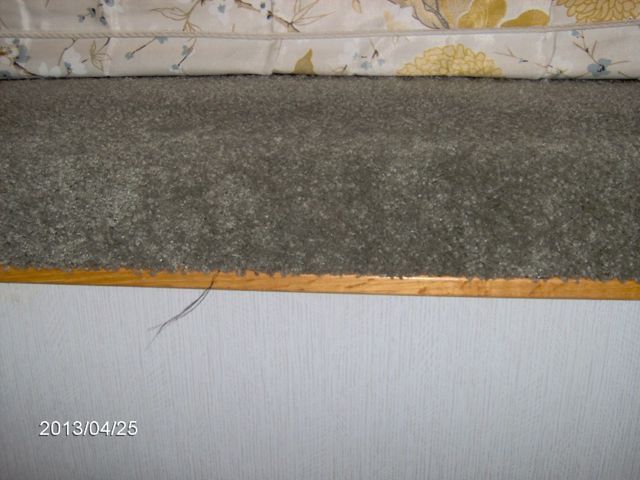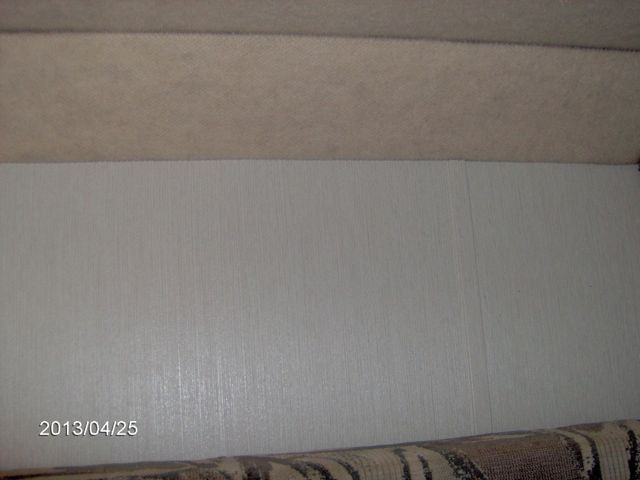|
|
Post by Jenni on Apr 29, 2013 13:22:33 GMT -5
I want to finish my front tack / sleeping area before my camping trip in August. It has a heater and air conditioner but right now it is just the bare aluminum walls so the air/heat doesn't make much difference. It's also really loud when it rains.
I know I need to buy the foam board type insulation of the proper width and cut it to fit in between the supports but what do I use to attach it to the trailer walls? Is there a certain kind of glue that will work best or tape? That's as far as needs to be done before we camp but then I would like to put panelling or something over the top. What is best to use for securing that to the walls? What other recommendations do you have for this "summer" project?
|
|
|
|
Post by pamz on Apr 30, 2013 5:23:30 GMT -5
I would think some type of double sided tape should work. I used Something called Rhino Grip that I bought at Lowe's to put stair treads on my stairs a couple of years ago. It is still sticking strong. I'm even able to vacuum them.
|
|
|
|
Post by ride4fun on Apr 30, 2013 8:38:50 GMT -5
Try horse trailer world. They have forums including one on trailers with lots of DIY trailer projects. www.horsetrailerworld.comMy trailer and my sisters were insulated before we bought them. Both have a fabric/wall paper type wall covering and I would think if you went with that rather than paneling you might want to just glue or staple the fabric to your foam boards before attaching them to the trailer. |
|
|
|
Post by Jenni on Apr 30, 2013 9:35:20 GMT -5
I've never seen anything like that r4f - any chance you could get me a picture?
Do your metal supports show through so it's like panels of covered insulation in between? I'm thinking it be like an upholstery fabric? That would be super easy for me to do myself without having to cut wood and use lots of power tools.
|
|
|
|
Post by ride4fun on Apr 30, 2013 9:56:41 GMT -5
Oops, I lied. At least on my trailer it is paneling on the walls. It looks like wallpaper texture to me, but I found a couple of scratches and its just a light paneling with no fake wood grain. On the roof is a very fuzzy upholstery fabric, almost feels like thin carpeting and the bottom of the nose looks like regular carpeting.  nose  wall and corner with trailer roof  roof |
|
|
|
Post by Jenni on Apr 30, 2013 10:30:26 GMT -5
Thanks for the pics
We used a similar panelling on our closet ceiling, except it had a texture like drywall. That's what I was considering using in the trailer. My trailer has carpeting on the floor, up the wall to the nose, and on the floor of the nose so I just need to do the walls and celing.
I like the fabric on the ceiling, that seems like it definitely would be easier to deal with. I wonder if it would work on the walls too. I was envisioning wrapping it around the edges of the cut insulation and then attaching those to the wall between the supports.
|
|
|
|
Post by Idaho Linda on Apr 30, 2013 14:28:13 GMT -5
|
|
|
|
Post by dawnh on May 1, 2013 17:28:14 GMT -5
I did that with my old trailer and if you cut those pieces just a wee bit big they wedge in there nicely no need to us any sort of adhesive. BUT one issue is once you heat that aluminum up your bars between the pieces sweat... and drip on your head every time...right after you finally get to sleep.....no matter where you lay... I know this for a fact...  ;D |
|
|
|
Post by pamz on May 1, 2013 19:23:53 GMT -5
|
|
|
|
Post by Jenni on May 2, 2013 8:10:26 GMT -5
I assume it does this behind whatever covers it too but it doesn't drip....So what happens to that moisture if you have it covered? How do you prevent it from molding behind the insulation or whatever you cover those bars with?
Linda that looks interesting but I think you have to buy all sorts of stuff to apply it and it would be super messy.
|
|
|
|
Post by dawnh on May 2, 2013 14:02:47 GMT -5
I never noticed that it molded could be the aluminum isn't condusive to that? But only used it in cold enough weather to need a heater a couple times and both times got dripped on some but seriously... needed the heat so REALLY didn't care LOL (both times with the sheriff's posse at trainings here in Michigan in early/mid April and it iced/snowed at one and was just plain cold/wet/miserable at another. I removed the insulation before I sold it nothing was under it. I did notice it helped keep the trailer cooler in summer it didn't have heat/air of it's own and no top vent in the dressing room.
|
|
|
|
Post by Jenni on May 2, 2013 14:53:30 GMT -5
Did you cover the foam insulation with anything? (like I was talking about with the fabric). I suppose maybe the foam itself wouldn't keep the moisture in but a fabric or other covering would absorb it and possibly mold. Of course if it was only a small amount and not very often maybe it would dry out enough to not mold.
I probably won't use the heater too often either but you never know. I actually have a heater/air conditioner unit that is installed in the ceiling. I did use it for part of the night when I camped back in Oct but without insulation it didn't do too great of a job so I didn't run it all night. While I did run it I didn't get dripped on but I did notice some condensation.
|
|
|
|
Post by Marci on May 2, 2013 17:42:08 GMT -5
What about the expanding foam stuff that comes in a can?
|
|
|
|
Post by Idaho Linda on May 2, 2013 18:30:14 GMT -5
Ah, Jenni---I have this stuff all over my house. I have it on my garage doors. I have it in sill plates. I even have made window coverings with it. I have never used anything to hold it in place, except for the window coverings, there I stapled it to a wooden frame to make it rigid so you could take it on and off. I've made bucket wraps with it to keep water from freezing. I've made covers for water bottles to keep them cold. Occasionally I've used a little duct tape or clear package tape--that is all. It is unbelievably handy--and cuts with a pair of scissors.
|
|
|
|
Post by ride4fun on May 2, 2013 21:16:44 GMT -5
Condensation happens when the steamy air touches a surface cooler than the dew point. If you use a bit thicker foam insulation that sticks out farther than the supports and then use something like the foam insulation in a spray can like Pam showed or the bubble wrap/foil insulation Linda mentioned which is relatively easy to cut into thin strips so you don't have the cold surfaces on the supports then the dew will probably only condense on the window glass.
|
|